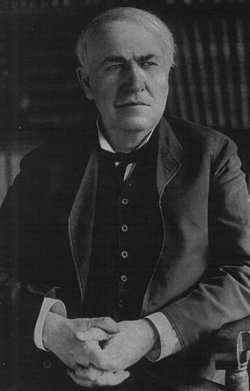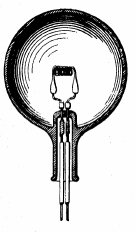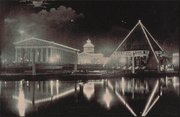Thomas Edison
|
|
Thomas Alva Edison (February 11, 1847 – October 18, 1931) was an American inventor and businessman who developed many important devices. "The Wizard of Menlo Park" was one of the first inventors to apply the principles of mass production to the process of invention.
Edison is considered one of the most prolific inventors of his time, holding a record 1,093 patents in his name. Most of these inventions were not completely original but improvements of earlier patents, and were actually made by his numerous employees. Edison was frequently criticized for not sharing the credits. Nevertheless, Edison received patents worldwide, including the United States, United Kingdom, France, and Germany. Edison started the Motion Picture Patents Company, which was a conglomerate of nine major film studios (commonly known as the Edison Trust).
In the early 1900s, Thomas Edison bought a house in Fort Myers, Florida (Seminole Lodge) as a winter retreat. Henry Ford, the automobile magnate lived across the street at his winter retreat (The Mangoes). They were friends until Edison died. The Edison and Ford Winter Estates are now open to the public.
| Contents |
Early years
Thomas Alva Edison's ancestors, the Dutch Edeson's, came to New Jersey in 1730. John Edeson remained loyal to England when the colonies revolted. That got him arrested and nearly hanged. He and his family fled to Nova Scotia, Canada, settling on land the British government gave those who had been loyal to it. In 1811, three generations of Edison's took up farming near Vienna, Ontario. Among them was Samuel Ogden Edison, Jr., a shingle maker, tailor, and tavern keeper who would marry Nancy Matthews Elliott.
John Edison had remained loyal to England in the 1700's. Ironically, in the 1800's, his grandson, Sam, would become a rebel joining the MacKenzie Rebellion that sought Canadian independence. The revolt failed and, like his grandfather, Sam fled for his life. He went to Port Huron, Michigan, temporarily leaving his wife Nancy and children behind.
From Port Huron, Sam Edison moved to Detroit, then Peru, Ohio, and finally to Milan, Ohio. That town was enjoying an economic boom. Sam's family joined him and in 1847 grew with the birth of their seventh child, Thomas Alva Edison. The economic success in Milan was soon over, though, and seven-year-old "Al" and his family moved again, this time to Port Huron, MI.
Thomas Edison had a late start in his schooling due to childhood illnesses. It was a late start and a poor start. His mind often wandered and shortly into his schooling his teacher, Alexander Crawford, was overheard calling him "addled". This ended Edison's three-months of formal schooling. His mother had been a school teacher in Canada and happily took over the job of schooling her son in his academics. Mrs. Edison encouraged and taught her son to read and experiment. Many of his lessons came from reading the book "Parker's School of Natural Philosophy".
Edison's life in Port Huron, Michigan was a bittersweet experience. It was his curious mind and want of knowing that got him into MUCH trouble. But it was here that he had his first labratory in the basement of his family home. At the tender age of twelve, Edison began work as a newsbutcher on the Grand Trunk Junction Railroad. He rode the trains daily, selling candy, fruits, and vegtables, from Port Huron, to Detroit and back again. He also worked as a pig slaughterer and started his own business selling vegetables. Around 1862, Edison printed and published The Weekly Herald. It was the first newspaper ever to be typeset and printed on a moving train. Today, the paper is known as the Port Huron [[Times-Herald]]. Partially deaf since adolescence, he became a telegraph operator after he saved the life of J.U. MacKenzie's son, Jimmie, from being struck by a runaway railcar. MacKenzie was so grateful, he took Edison under his wing and trained him as a telegraph operator. Edison's deafness aided him with his telegraphy work as it blocked out noises and prevented Edison from hearing the telegrapher sitting next to him. Some of his earliest inventions related to electrical telegraphy, included a stock ticker.
Edison applied for his first patent, the electric vote recorder, on October 28, 1868.
Middle years
Thomas_Edison,_1878.jpg
Thomas Edison began his career as an inventor in Newark, New Jersey with the stock ticker and other improved telegraphic devices, but the invention which first gained Edison wide fame was the phonograph in 1877. While non-reproducible sound recording was first achieved by Leon Scott de Martinville (France, 1857), and others at the time (notably Charles Cros) were contemplating the notion that sound waves might be recorded and reproduced, Edison was the first to publicly demonstrate a device to do so. This accomplishment was so unexpected by the public at large as to appear almost magical. Edison became known as "The Wizard of Menlo Park" after the New Jersey town where he resided. His first phonograph recorded onto tinfoil cylinders that had low sound quality and destroyed the track during replay so that one could listen only once. A redesigned model using wax cylinders was produced soon after by Alexander Graham Bell. Sound quality was still low, and replays were limited before wear destroyed the recording, but the invention enjoyed popularity. The "gramophone", playing gramophone records, was invented by Emile Berliner in 1887, but in the early years, the audio fidelity was worse than the phonograph cylinders marketed by Edison Records.
Menlo Park
Edison's major innovation was the Menlo Park research lab, which was built in New Jersey. It was the first institution set up with the specific purpose of producing constant technological innovation and improvement. Edison was the inventor of most of the inventions produced there, though he primarily supervised the operation and work of his employees.
Most of Edison's patents were utility patents, with only about a dozen being design patents. Many of his inventions were not completely original, but improvements which allowed for mass production. For example, contrary to public perception, Edison did not invent the electric light bulb. Several designs had already been developed by earlier inventors including Joseph Swan, Henry Woodward, Mathew Evans, James Bowman Lindsay, William Sawyer, Humphrey Davey, and Heinrich Göbel. In 1878, Edison applied the term filament to the element of glowing wire carrying the current, although English inventor Joseph Swan used the term prior to this. Edison took the features of these earlier designs and set his workers to the task of creating longer-lasting bulbs. After Edison purchased the Woodward and Evans patent of 1875, his employees experimented with a large number of different materials to increase the bulb's burning time. By 1879, they had increasied the burning time enough to make the light bulb commercially viable. While the earlier inventors had produced electric lighting in laboratory conditions, Edison concentrated on commercial application and was able to sell the concept to homes and businesses by mass-producing relatively long-lasting light bulbs and creating a system for the generation and distribution of electricity.
The Menlo Park research lab was made possible by the sale of the quadruplex telegraph that Edison invented in 1874. The quadruplex telegraph could send four simultaneous telegraph signals over the same wire. When Edison asked Western Union to make an offer, he was shocked at the unexpectedly large amount that Western Union offered; the patent rights were sold for $10,000. The quadruplex telegraph was Edison's first big financial success.
Incandescence era
In 1878, Edison formed Edison Electric Light Company in New York City with several financiers, including J.P. Morgan and the Vanderbilts. Edison made the first public demonstration of incandescent lighting on December 31, 1879, in Menlo Park. On January 27, 1880, he filed a patent in the United States for the electric incandescent lamp.
On October 8, 1883, the U.S. patent office ruled that Edison's patent was based on the work of William Sawyer and was invalid. Litigation continued until October 6, 1889, when a judge ruled that Edison's electric light improvement claim for "a filament of carbon of high resistance" was valid. After losing a court battle with Joseph Swan, they formed a joint company (Ediswan) to market the invention. This company and its technological heritage became General Electric in 1892.
In 1880, Edison patented a electric distribution system. The first investor-owned electric utility was the 1882 Pearl Street Station, New York City. On January 25, 1881, Edison and Alexander Graham Bell formed the Oriental Telephone Company. On September 4, 1882, Edison switched on the world's first electrical power distribution system, providing 110 volts direct current (DC) to 59 customers in lower Manhattan, around his Pearl Street laboratory. On January 19, 1883, the first standardized electric lighting system employing overhead wires began service in Roselle, New Jersey.
Template:Multi-video start Template:Multi-video item Template:Multi-video end
War of Currents era
Main article:War of Currents
During the initial years of electricity distribution, Edison's DC was the standard for the United States, and Edison was not disposed to lose all his patent royalties. During the "War of Currents" era, Serbian immigrant Nikola Tesla and Edison became adversaries due to Edison's promotion of DC for electric power distribution over the more efficient alternating current (AC) advocated by Tesla, who patented AC in Graz, Austria. Edison (or, reportedly, one of his employees) employed the tactics of misusing Tesla's patents to construct the first electric chair for the state of New York to promote the idea that AC was deadly. Popular myth has it that Edison invented the electric chair, despite being against capital punishment, solely as a means of impressing the public that AC was more dangerous than DC. In fact, like most of the output of the Menlo Park operations, the chair was primarily invented by a few of his employees, in particular Harold P. Brown, while Edison supervised their operations. [1] (http://inventors.about.com/library/weekly/aa102497.htm)
Edison went on to carry out a campaign to discredit and discourage the use of AC. Edison presided personally over several electrocutions of animals, primarily stray cats and dogs, for the benefit of the press to prove that his system of DC was safer than that of AC. Edison's series of animal executions peaked with the electrocution of Topsy the Elephant.
Many of Edison's inventions using DC ultimately lost to AC devices proposed by others. AC distribution systems replaced DC, enormously extending the range and improving the safety and efficiency of power distribution. Since the 1950s, high voltage direct current (HVDC) transmission systems have become more common in certain situations.
Work relations
As exemplified by the light bulb, most of Edison's inventions were improvements of ideas by others, achieved through a diligent and industrial approach and team-based development. He was the undisputed head of the team, but usually did not share credit for the inventions. He himself said: "genius is one percent inspiration, ninety-nine percent perspiration." Nikola Tesla, possibly Edison's most famous employee who went on to be a great scientist and inventor in his own right, said about Edison's method of problem-solving: "If Edison had a needle to find in a haystack, he would proceed at once with the diligence of the bee to examine straw after straw until he found the object of his search. I was a sorry witness of such doings, knowing that a little theory and calculation would have saved him ninety percent of his labor."
Frank J. Sprague, a former naval officer, was recruited by Edward H. Johnson, and joined the Edison organization in 1883. Sprague was a good mathematician, and one of Sprague's significant contributions to the Edison Laboratory at Menlo Park was the introduction of mathematical methods. Prior to his arrival, Edison conducted many costly trial-and-error experiments. Sprague's approach was to calculate the optimum parameters and thus save much needless tinkering. He did important work for Edison, including correcting Edison's system of mains and feeders for central station distribution. In 1884, Sprague decided his interests in the exploitation of electricity lay elsewhere, and he left Edison to found the Sprague Electric Railway & Motor Company. However, Sprague, who later developed many electrical innovations, always credited Edison for their work together.
Media inventions
The key to Edison's fortunes was telegraphy. With knowledge gained from years of working as a telegraph operator, he learned the basics of electricity. This allowed him to make his early fortune with the stock ticker, the first electricity-based broadcast system.
Edison holds the patent for the motion picture camera, but it is argued that William Kennedy Laurie Dickson actually invented it while working in the Menlo Park research lab. As with the electric light, an improvement upon ideas developed by others. Edison established the standard of using 35 mm (then 1 and 3/8 inches) film with 4 perforations on the edge of each frame that allowed film to emerge as a mass medium. He built what has been called the first movie studio, the Black Maria, in New Jersey. There, he made the first copyrighted film, Fred Ott's Sneeze. In 1902, a US court rejected Edison's claim that he be granted sole rights over all aspects of movie production in the case "Edison v. American Mutoscope Company" [2] (http://www.digitalhistory.uh.edu/historyonline/edison_mutoscope.cfm).
In 1891, Thomas Edison built a Kinetoscope, or peep-hole viewer. This device was installed in penny arcades, where people could watch short, simple films. This was especially important to Thomas Edison because he had been searching for a way to entertain customers that were listening to music on his phonograph. Now, people could go to a penny arcade, put in a coin, put on the headphones, and watch a film through the peep-hole.
On August 9, 1892, Edison received a patent for a two-way telegraph.
In 1894, Edison experimented with synchronizing audio with film; the Kinetophone loosely synchronized a Kinetoscope image with a cylinder phonograph. In April of 1896, Edison and Thomas Armat's Vitascope was used to project motion pictures in public screenings in New York City.
Personal life
Thomas Edison was an Agnostic. He was married twice, the first time in 1871 to Mary Stilwell (1855-1884), with whom he had three children—Marion Estelle, Thomas Jr., and William Leslie—before she died at age 29, probably of typhoid fever. His second marriage was to Mina Miller (1865-1946), also with three children, Madeleine, Charles (who took over the company), and Theodore Miller. He purchased a home known as Glenmont in 1886 as a wedding gift for Mina in West Orange, New Jersey. The remains of Thomas and Mina Edison are now buried there. The 13.5 acre (55,000 m²) property is maintained by the National Park Service as the Edison National Historical Site.
His contributions to technology benefited people world-wide, and in 1878, he was named Chevalier of the Legion of Honor of France, and in 1889 was made a Commander in the Legion of Honor.
List of contributions
Main article : List of Edison patents
For a discussion of Edison's Record company and its role in the recording industry, see: Edison Records. See also incandescent light bulb.
Improvements of Edison's work
- Lewis Latimer patented an improved method of producing the filament in light bulbs.
- Nikola Tesla developed alternating current distribution, which could be used to transmit electricity over longer distance than Edison's direct current due to the ability to transform the voltage.
- Emil Berliner developed the gramophone, which is essentially an improved phonograph, with the main difference being the use of flat records with spiral grooves.
- Edward H. Johnson had light bulbs specially made, hand-wired, and displayed at his home on Fifth Avenue in New York City on the first electrically-illuminated Christmas tree on December 22, 1882.
Tributes
The town of Edison, New Jersey, and Thomas Edison State College, a nationally-known college for adult learners in Trenton, New Jersey, are named for the inventor. There is a Thomas Alva Edison Memorial Tower and Museum in the town of Edison.
Life magazine (USA), in a special double issue, placed Edison first in the "100 Most Important People in the Last 1000 Years", noting that his light bulb "lit up the world".
The City Hotel, in Sunbury, Pennsylvania, was the first building to be lit with Edison's three-wire system. The hotel was renamed The Hotel Edison, and retains that name today.
External links
Biography
- Template:Gutenberg
- Dyer, Frank Lewis, "Edison, His Life And Inventions (http://www.worldwideschool.org/library/books/hst/biography/Edison/toc.html)". (Worldwideschool.org)
- Beals, Gerry, "Thomas Edison (http://www.thomasedison.com/)"
- Murphy, John Patrick Michael, "Thomas Alva Edison (http://www.infidels.org/library/modern/john_murphy/edison.html)"
Historic sites
- Edison Birthplace Museum (http://www.tomedison.org/)
- Thomas Edison House (http://www.edisonhouse.org/)
- Edison National Historic Site (http://www.nps.gov/edis/)
- Menlo Park (http://www.edisonnj.org/menlopark/)
Archives
- Thomas A. Edison Papers at Rutgers University (http://edison.rutgers.edu/)
- Thomas Edison's Patents - Rutgers University (http://edison.rutgers.edu/patents.htm)
- Edisonian Museum Antique Electrics (http://www.edisonian.com/)
- Thomas A. Edison in his laboratory in New Jersey, 1901 (http://www.americaslibrary.gov/aa/edison/aa_edison_subj_e.html)
- "Edison's Miracle of Light (http://www.pbs.org/wgbh/amex/edison/)". American Experience, PBS.
Relations
- One Story of Nikola Tesla (http://www.flyingmoose.org/truthfic/tesla.htm) : Anecdotes concerning the relationship of Tesla and Edison.
Writings and speech
- Edison, Thomas A., The Philosophy of Thomas Paine (http://www.aldeism.com/paine.html). June 7, 1925. (essay)



